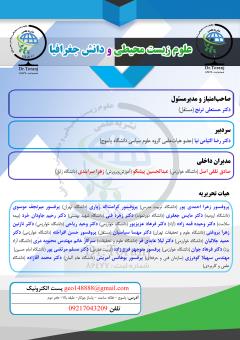زیست پذیری محلات شهری با رویکرد توسعه پایداردر منطقه یک شهرداری کرج
محورهای موضوعی : علوم جغرافیا (کلیه گرایشها)محمد رامیان 1 , آزاده اربابی سبزواری 2
1 - دانشگاه آزاد اسلامی واحد اسلامشهر
2 - دانشگاه آزاد اسلامی واحد اسلامشهر
کلید واژه: زیست¬پذیری, توسعه پایدار, محلات پایدار, شهرکرج ,
چکیده مقاله :
امروزه برخورداری از خصوصیات زیست پذیری برای شهرها و بهویژه کلانشهرها ضرورت یافته است. ازاینرو پژوهش حاضر می-کوشد میزان زیست پذیری محلات شهریِ منطقه یک شهرداری کرج را ارزیابی کند. روش پژوهش بهصورت ارزیابی-مقایسه ای بوده و جمع آوري اطلاعات مبتنی بر اطلاعات کتابخانه ای و داده های اسنادی و میدانی به صورت پيمايشي صورت گرفته است در هر محله با توزيع و تكميل پرسشنامه و بهره گيري از مدل ELECTERE وضعيت پایداری در زیست پذیری و رتبهبندی محلات مشخصشدهاند. نمونه آماری به روش تصادفی و با استفاده از مدل کوکران به تعداد 385 انتخابشده است. زیست پذیری محلات در چهار بعد ارزیابیشده است. که درمجموع محلات شمالی منطقه (حوزه 1) بهعلاوه محله یک (واقع در حوزه 2) سطح پایداری بالاترین را در زیست پذیری نشان داده اند. از ابعاد موردبررسی می توان نتیجه گرفت که محلات منطقه به لحاظ پایداری و زیست-پذیری از سطح بالا به پایین به ترتیب این گونه بوده اند: 5، 1، 4، 8، 6، 9، 7، 2، 11، 10 و 3 . درمجموع محلات شمالی منطقه (حوزه 1) بهعلاوه محله یک (واقع در حوزه 2) سطح پایداری بالاتری را نشان داده اند که به مهمترین دلایل آن اشاره می شود: وسعت محدوده فضای سبز ، کم بودن میزان آلودگی هوا، دسترسی بهتر به امکانات و خدمات و فضای سبز بیشتر و طراحی از پیش تعیینشده و بافت منظم، تراکم پایین ، وجود فرصتهای شغلی بیشتر و سطح اجتماعی بالاتر این محلات بوده است. همچنین در محلات جنوبی (حوزه 1) سطح پایداری پایین تری ملاحظه گردید. مهمترین دلایل پایین بودن پایداری وضعیت نامطلوب معابر و پیاده روها و تراکم بسیار بالاو معابر با عرض کم و کمبود امکانات و خدمات مختلف، امنیت پایین ساکنان، بیکاری بالا و درآمد کم و ساخت و سازهای بدون مجوز و املاک بدون سند و حضور کاربری های ناسازگار در کنار بافت مسکونی و کمبود فضای سبز، وجود انواع آلودگی ها و بافت فرسوده اشاره کرد.
Today, it is necessary to have livable characteristics for cities and especially metropolises. Therefore, the present study tries to evaluate the livability of the urban areas of one Karaj municipality region. The research method is evaluation-comparative and the collection of information based on library information and documentary and field data has been carried out in the form of a survey in each neighborhood by distributing and completing questionnaires and using the ELECTERE model. Sustainability in livability and neighborhood ranking are specified. A statistical sample of 385 was selected by random method using Cochran's model. The livability of neighborhoods has been evaluated in four dimensions. that in total, the northern neighborhoods of the region (Area 1) in addition to neighborhood 1 (located in Area 2) have shown the highest level of sustainability in livability. From the examined dimensions, it can be concluded that the localities of the region in terms of stability and livability from top to bottom were as follows: 5, 1, 4, 8, 6, 9, 7, 2, 11 , 10 and 3. In total, the northern neighborhoods of the region (area 1) in addition to neighborhood 1 (located in area 2) have shown a higher level of sustainability, the most important reasons for which are pointed out: the extent of the green area, the low level of air pollution, better access to facilities. And more services and green space and predetermined design and orderly texture, low density, more job opportunities and higher social level of these neighborhoods. Also, a lower level of stability was observed in the southern neighborhoods (zone 1). The most important reasons for the low stability of the roads and sidewalks and very high density and narrow roads and lack of various facilities and services, low security of residents, high unemployment and low income and constructions without permits and properties without documents and He pointed out the presence of incompatible uses in addition to the residential fabric and the lack of green space, the existence of various types of pollution and dilapidated fabric..
